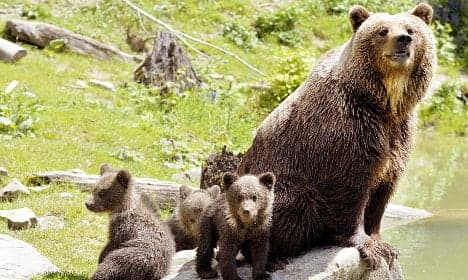Mother bears use 'human shields' against killer males

Brown bear mothers in a Swedish forest use human "shields" against murderous males, overcoming their own fear to raise defenceless cubs near villages where hunters live, researchers said on Wednesday.
Some young bear mothers have taken to living closer to humans for the duration of the mating season -- a period which sends male bears, called boars, into frenzies of lust-fuelled cub killing.
Motherly instinct, in other words, seems to trump sex drive.
While sows grin and bear the potentially threatening human proximity for the sake of their offspring, boars continue to give the two-legged species a very wide berth.
"Bears in general avoid areas close to humans," said Sam Steyaert of the Norwegian University of Life Sciences, who co-authored the study in the journal Proceedings of the Royal Society B.
"Also, after the mating season, females with cubs change their behaviour" and go back to avoiding humans, who hunt bears in the forest during a designated season.
Male brown bears kill cubs to trigger oestrus -- a period of sexual receptivity -- in females who would otherwise have come into heat only after raising their cubs to independence.
This means that instead of having to wait 18-30 months, the males "can obtain a mating opportunity in just a few days," Steyaert told AFP.
The behaviour is called sexually selected infanticide, and has also been observed in birds, bats, primates and big cats.
It is common in brown bears, with as much as a third of cubs in the Swedish forest losing their lives to roving males during the annual mating season, from early May to mid-July.
Steyaert and a team tracked 26 mother bears using GPS technology between 2005 and 2012.
Of the sows, 16 successfully raised cubs, and 10 failed.
"The median distance of successful females to human habitation was about 780 metres," Steyaert told AFP by email.
For unsuccessful ones it was 1,210 metres, nearly half a kilometre farther away.
"Successful mothers were more likely to use humans as protective associates, whereas unsuccessful mothers avoided humans," the study concluded.
Other, less successful strategies, included trying to fight off the aggressors.
Comments
See Also
Some young bear mothers have taken to living closer to humans for the duration of the mating season -- a period which sends male bears, called boars, into frenzies of lust-fuelled cub killing.
Motherly instinct, in other words, seems to trump sex drive.
While sows grin and bear the potentially threatening human proximity for the sake of their offspring, boars continue to give the two-legged species a very wide berth.
"Bears in general avoid areas close to humans," said Sam Steyaert of the Norwegian University of Life Sciences, who co-authored the study in the journal Proceedings of the Royal Society B.
"Also, after the mating season, females with cubs change their behaviour" and go back to avoiding humans, who hunt bears in the forest during a designated season.
Male brown bears kill cubs to trigger oestrus -- a period of sexual receptivity -- in females who would otherwise have come into heat only after raising their cubs to independence.
This means that instead of having to wait 18-30 months, the males "can obtain a mating opportunity in just a few days," Steyaert told AFP.
The behaviour is called sexually selected infanticide, and has also been observed in birds, bats, primates and big cats.
It is common in brown bears, with as much as a third of cubs in the Swedish forest losing their lives to roving males during the annual mating season, from early May to mid-July.
Steyaert and a team tracked 26 mother bears using GPS technology between 2005 and 2012.
Of the sows, 16 successfully raised cubs, and 10 failed.
"The median distance of successful females to human habitation was about 780 metres," Steyaert told AFP by email.
For unsuccessful ones it was 1,210 metres, nearly half a kilometre farther away.
"Successful mothers were more likely to use humans as protective associates, whereas unsuccessful mothers avoided humans," the study concluded.
Other, less successful strategies, included trying to fight off the aggressors.
Join the conversation in our comments section below. Share your own views and experience and if you have a question or suggestion for our journalists then email us at [email protected].
Please keep comments civil, constructive and on topic – and make sure to read our terms of use before getting involved.
Please log in here to leave a comment.